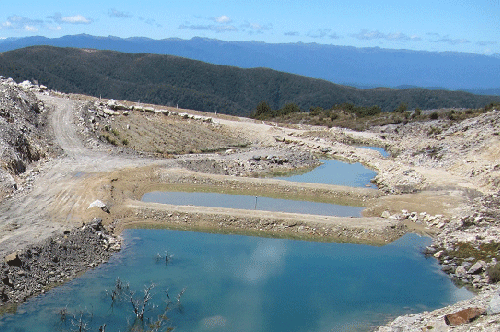Mussel shells cleaning up mine sites capture international interest
Mussel shell bioreactor (centre) at Stockton Mine on a spectacular day. Three hundred and twenty tonnes of shells treats two to three litres per second of pH3.2 water, neutralising it to around pH5 and removing dissolved metals as oxides, hydroxides and sulphides. Photo: CRL Energy.
CRL Energy and O’Kane Consultants researchers are gaining an international reputation for innovation in mine site environmental management, with collaboration or uptake of their processes now in the
Dr Pope explains that at the abandoned Bellvue Mine, near Greymouth, 120 tonnes of shells neutralise the acidity by increasing pH from as low as 2.7 to about 7 and remove dissolved Fe, Al, Zn, Ni and other metal contaminants from waste water passing through the system. “There is interest in the
CRL Energy manage the government-funded New Zealand Mine Environment Life Cycle Guide research programme; a multidisciplinary collaboration including University of Canterbury, University of Otago, Landcare Research, and O’Kane Consultants NZ Ltd. The programme focuses on the environmental science needed to assist the minerals sector in gathering the right data prior to mining or early in mine development so that positive and successful rehabilitation is achieved at mine closure.
The science disciplines are split into geochemical science and ecological science. The geochemical science is mostly related to prediction of waste rock, soil and mine drainage properties and development of passive treatment or management/mitigation technologies. The ecological science is related to ecological impact/ecotoxicity, aquatic ecosystem recovery and terrestrial ecosystem reconstruction.
The research team have case study sites located at about 20 historic or active mine sites throughout New
“Our research identifies different time trajectories of various rehabilitation techniques and critical risks that must be managed for rehabilitation to be successful. Another example is our passive mine drainage treatment research which includes genetic analysis of microbiological consortia that catalyse re-dox reactions that occur during treatment in these systems. Our research seeks to identify critical micro-organisms or communities, optimise conditions for their activity and develop small-footprint, accelerated biogeochemical mine drainage treatment systems.
“In a broad sense, our programme seeks to minimise risk for the
Date posted: 5 December 2017

